These are not the droids you're looking for...
Sam Hart
2010-02-03 20:32:22Approximately 4 or 5 years ago I made what I considered a pretty major phone purchase. I replaced my existing cheap whatever this was with a shiny, new T-Mobile MDA. The HTC built MDA was an absolute monster of a phone compared to what I had before. It was Windows Mobile based, which meant I could install applications, browse the web, use SSH on it, even edit code and use Blender. I know functionality like this wasn't new to many people at the time, but it sure as hell was new to me. Even though I wasn't a huge fan of Windows Mobile, compared to the alternatives at the time (Blackberry, Palm, and other custom "bleh") it was pretty damned rocking.
Well, 4-5 years have passed, I've gone through two jobs, started my own business, and my faithful little phone has quickly aged and lost much of its usefulness. I long ago lost the desire to use it for anything other than phone calls. Its camera sucks compared to other digital cameras we have. No one supports my ancient tech any more, so new applications are few and far between. And the Windows Mobile environment seems to have somehow degraded over time such that it's always sluggish and often glitchy. I've had other friends who have had similar complaints about Windows Mobile in the past, but I really didn't start getting bothered by my phone until late in 2009.
So we decided to get a new phone, but, as I tend to do with everything, I really didn't want to get some stopgap solution that would hold me for a few months and then lose its usefulness due to it being obsoleted before I even get it. Thus, the question became, what do I want next?
Windows Mobile was out; it simply hasn't been able to keep up with the times, IMHO. The latest 6.x releases I've seen all look and feel like my, now ancient, MDA. Windows Mobile 7 sounds slightly interesting, especially if the Silverlight UI redesigns are true, but with their "late-to-the-party" and half-assed app marketplace (with no XNA support until Windows Mobile 7) it doesn't have enough going for it for me to want to wait for it.
Blackberry is out as I've never been impressed by it. Blackberry suffers from the same classic problems people complained Linux used to have; it's by far too serious, ugly, and clunky to be remotely enjoyable to use. Even the recent UI revamp they've done to try and "fun" it up has been too little, too late. Plus, they have their own app store deficiencies.
Then there's Apple, who certainly has the tech du jour. But I've never liked Apple's products largely because of how much they limit you. UIs that hide features from power users such as myself, hardware design that eliminate features and functionality that I require simply to make it appealing to the masses (it's supremely fucktarded that you can't pop out and replace the battery in your iPhone, and that it has no external storage slots), Apple tends to produce products that piss me off entirely too much to own and enjoy. Further, it seems that in order for a power user like myself to actually use and enjoy Apple tech they wind up having to drink the Apple technology koolaid, and I'm someone who has never been able to participate in such cult-like behavior with my gadgets.
Palm is out because they are on their last legs and I'd be very surprised if they will still be around in a few years. Palm Pre is Linux-based, which is definitely a plus for me, their package distribution model is novel for third-party apps, and the UI is actually pretty impressive with some unique and new concepts in it that I'd like to see other mobile OSes mimic. However, while I like the concept of the card system, I worry it'll lead to the exact same problems I used to bitch about with my older Palm-based devices years ago: namely that I'll have a tendency to open entirely too many apps at once and the inherent process management (or lack-thereof) that this design implies will result in a system that's sluggish and unresponsive until I clean up unused running apps myself (to some extent Windows Mobile has this same problem, but there you usually have clear ways to actually intentionally exit applications from within the applications themselves). Basically, I worry that with a Palm Pre I'll wind up having to micromanage as much as I used to have to do on my older Palm-base devices.
All of this leads me to Google, and their Android OS. Android is also Linux based, and, honestly, a better design internally to Palm's webOS IMHO. Quick perusing of the code shows that Android tends to favor more open modules than webOS does, which means it's infinitely more hackable. But the real strength lies in the fact that the layer that separates the low level kernel stuff from the higher level app-space stuff is a customized JVM which means we can finally see some of the cross-platform promises of the Java platform fulfilled. Say what you will about Java (and I know I personally dislike it), the fact that much of the higher level stuff is completely hardware agnostic will do wonders for platform support down the road. Palm's webOS has some similar functionality with a JavaScript VM, but it runs much too high in the stack to alleviate cross-platform concerns.
Additionally, Android is backed by a solid group of companies and organizations (other than just Google) in its parent Open Handset Alliance. This gives me confidence that the platform will live and thrive.
While the initial Android-based devices to hit the market met with tepid reviews, and it was pretty universally agreed upon that they kind of sucked but had great potential, the recent Android updates seem to have addressed most (if not all) of the original complaints. Furthermore, Google's recent Nexus One has had some highly favorable reviews and is a veritable monster with regard to mobile processing power, and the Android Marketplace has really been gaining steam.
So, I did it... I bit the bullet and got myself a Nexus One. It came yesterday, and I've had around 24 hours now to play around with it. Here's my experience thus far.
Unpacking

The box was sent FedEx overnight with Google footing the bill. I thought that was incredibly cool and a class act on Google's part. Yes, the phone is somewhat expensive and some may argue that this is the least they can do, but considering the cost of the hardware I'd seriously doubt their profits per unit sold are high enough to justify it.
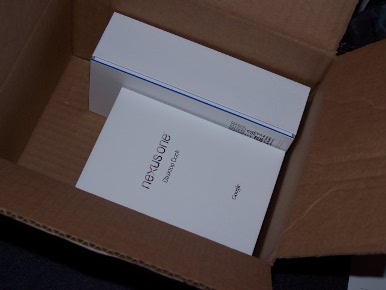
Unboxing it reveals... more boxes. This is to be expected, but I still have a distaste for excessive packaging. Supposedly these inner boxes contain some post-consumer recycled material, but other than some mentions online I can't find any further details actually on the boxes. The ink used on the boxes was soy-based, however, which is pretty cool.

These inner-boxes are actually quite visually appealing with their minimalist design and fading Nexus One logo. As you can see, I splurged and got the "Desktop Dock" for the phone.
It's actually kind of a misleading name for this dock. It doesn't actually seem to be designed specifically for use with a computer as it only has one USB connector that is shared with the power supply. I, personally, would assume "Desktop" means that it would be something I put on my desk, connect it to my computer for synchronization and what-not, and charge it with the external charger at the same time. In reality it seems this "Desktop Dock" is designed more to link the device to external speakers and use it as a media player (which is dumb considering the stock media player app is kind of clunky). So, it's more of a "Media Dock" than a "Desktop Dock".
At any rate, my intention for this dock was never to use it with my desktop so it hardly matters to me. I am planning on using this at the side of my bed so my phone can double as an alarm clock (I haven't had an alarm clock on my side of the bed in 4+ years, and figured it's high time I had one).
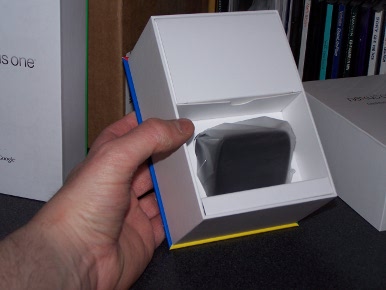 | 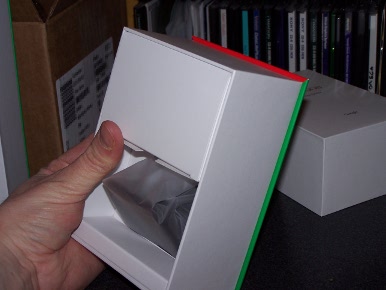 |
I commented before on how I liked the box design. One thing I didn't mention was that they have little box edge highlights which are the Google colors. Kind of cool.
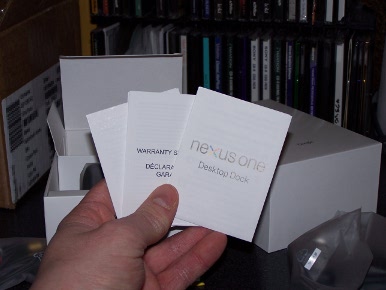 | 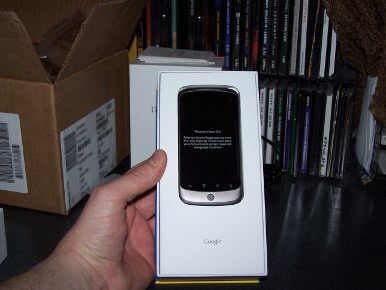 |
Teeny tiny manuals that are next to useless. The actual phone one (not pictured) is hardly a manual at all, and just contains warnings, notices, and other dull legalese. It seems Google is relying pretty heavily on their online sources for documentation, but even that is a bit sparse considering their history. Much of the "documentation" for the phone seems to just be Youtube videos, which hardly go into any useful detail. Not that it matters much as I can figure out most of this stuff myself, but I'd imagine someone else may have a harder time. Then again, I've heard this is a pretty universal problem with most modern cell phones, so I don't know why I'm so surprised.
The phone itself is pretty nifty looking in its box coffin.
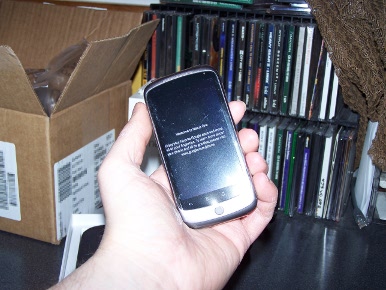 |  |
The phone fits quite comfortably in my hands, something I like since I have huge hands and many phones these days feel small and awkward to hold. That's not to say it's huge, because it really isn't. I'm just pointing out that I like the dimensions and they fit me well.
I did notice that the phone was a noticeably heavier than my old MDA, which I assume has to do with the fact that it has an actual metal frame, a rather large screen, and a more modern battery. However, from what I've read in other reviews of the device it's actually either comparable or lighter than most similar phones. The phone is not uncomfortably heavy by any stretch of the imagination, I wont feel like I'm carrying a brick around in my pocket, but it is heavier than my last phone.
The carrying case is just your standard fabric pocket that every electronic device comes with these days. It offers no real protection except from scratches to the screen, and I'll probably replace it sometime soon.
I also think the Android guy peaking out from the fabric has a real Pedobear aspect to it... but maybe that's just me.
 |  |
The Nexus One is a bit taller than my old phone, but is quite a bit thinner. Granted, my MDA had a physical keyboard in it, which makes comparisons like this fairly silly. I'm merely wanting to show the size differences because it's something I'm going to be carrying around, and that makes this difference relevant.
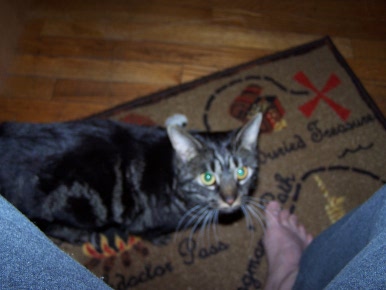
Unboxing and setting up my Nexus One was kind of hard because I had a spectator who was more interested in loving and affection than my expensive piece of metal and plastic.
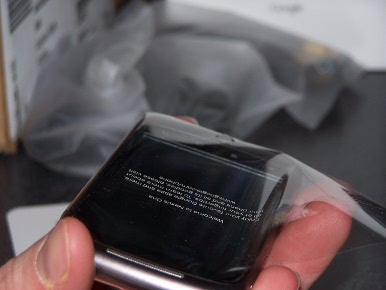
The Nexus One has a trackball at its base (which some people say isn't the most useful thing considering you don't really need it). So far, my biggest problem with it was that the protective plastic around the phone got caught on it as I was removing it. It wasn't that hard to dislodge, but I did feel a need to be extra careful with it so that it didn't damage the phone.
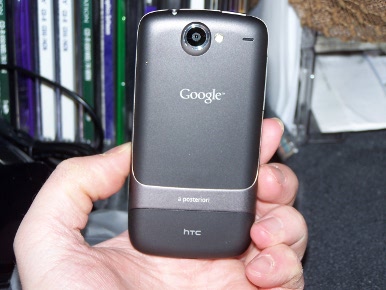
Google lets you engrave your phone for free. It makes exchanges and repairs a bit of a problem, but is an otherwise really cool feature.
Last week when I was making my purchase, this engraving was actually my biggest barrier to overcome. I had an incredibly hard time coming up with something to put there. A friend of mine suggested the three laws of robotics, which would have been absolutely perfect for an "Android" phone, but you are limited to only two lines of text and a small number of characters so they wouldn't have fit. We also toyed with various Hitchhiker's Guide to the Galaxy references (everything from '42' in binary to Marvin quotes), but none really stuck with me. "This is not the droid you are looking for" was an obvious choice (and what I went for in this post), but it was almost too obvious of a choice.
Eventually, I just went with a posteriori (knowledge or justification is dependent on experience or empirical evidence) which sums up my general philosophy pretty well.
 | 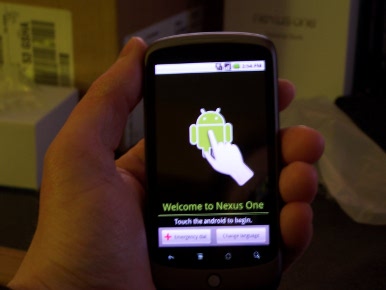 |
Finally, after charging it, I was ready to set it up. When you turn it on, you're greeted with the above screen where you have to poke the Android-guy in his belly, apparently. It's either "popping fresh" or "bad touch", I can't exactly tell which.
Camera picture quality
I'll admit the quality of the pictures from my cell phone isn't a major concern for me any more. I have a better camera now that I'm using for pictures I actually care about, so my cell phone camera is only for those situations where I don't actually have my real camera and absolutely have to snap a pic. However, I tested it anyway.
 |
| From Drop Box |
All-in-all, it's a very nice camera for a cell phone. It's certainly a massive improvement over what I use to have. But by far the coolest feature of it is that I can very easily upload pictures from my camera directly to Picasa without any rigmarole or ceremony. That is absolutely killer.
My only gripe about this Picasa integration right now is that it exposed some images I apparently had stored in my old phone's card and uploaded them without my permission. The pictures were ones I had used for my old phone's wallpaper at various points of its existence, so none of them were embarrassing to be shared. Still, it shouldn't have done this without my knowledge or permission.
One other baffling thing here is that I can't actually find these older wallpaper images on my phone. They are stored someplace far far away from any GUI tool I've been able to throw at it. So I can't actually delete them from my device.
The Interface
I've used the phone for roughly 24 hours now, and can share my impressions with the interface in general.
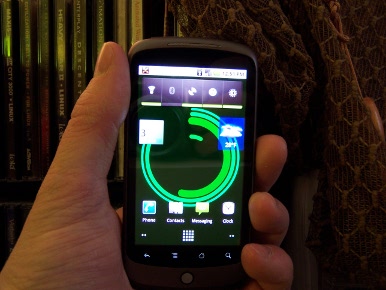
First, it is very clean and versatile. I like the widget model as well as being able to populate my desktop (boy, this term needs to be revised as it no longer fits cellphones) with various folders, apps, and tools at my discretion.
By far my favorite feature of the interface is the fact that you have multiple desktops (5 on the Nexus One). Being able to divide up my tasks and work among multiple desktops is one of my absolute favorite things about working under Linux, and I love that I can now do that with my phone. I'm yet to come up with an organization I'm thrilled with, but I know it's only a matter of time before I do.
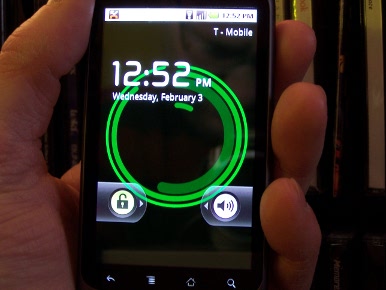
Google has come up with a pretty cool phone lock/unlock interface. By default you just swipe the above "lock" icon from left to right to unlock the phone, but you can apparently define all sorts of wacky gestures and movements to unlock the phone if you want. Personally, I'm happy with the default and am not looking to make a secret handshake with my phone just yet.
You'll see in these pictures that I'm using a live wallpaper, which is a wallpaper that basically is animated and moves. I like the idea of the live wallpapers, but I'm not 100% certain I'll use them all the time. There's rumors that some of them can be a bit of a battery drain, and it's noticeable that some of the more complex ones slow the machine down a bit (my favorite is easily "Magic Smoke" but it causes noticeable jerkiness when you slide about the desktops).
There's been reports of general buggy behavior with these live wallpapers online, and nearly every Youtube video I've found that showcases them has a crash of the wallpapers at some point during the demonstration. However, I'm yet to encounter one of these crashes, which could have more to do with the fact that I avoid some of the buggier ones simply because they don't appeal to me (like the grass one).
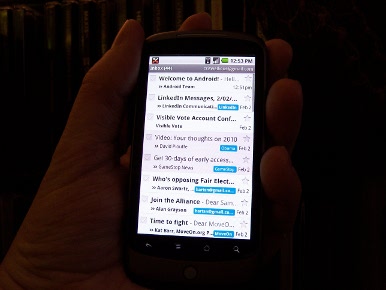
One killer feature is how well the phone integrates with the various web-based Google services. I'll readily admit I've come to depend on them entirely too much in the last few years, so having them integrate tightly with my phone is kind of a must at this point.
Gmail integration is especially nice because it supports all of the Gmail features you need the most, including labels and the resultant virtual folders that they provide. My only beef is that it doesn't use the custom color schemes I have set up for my labels in Gmail proper, which means that it's a tiny bit harder to find the specific label I'm looking for. But this is a minor gripe, and probably a good thing considering how much extra and potentially useless data it would have to sync with.
 | 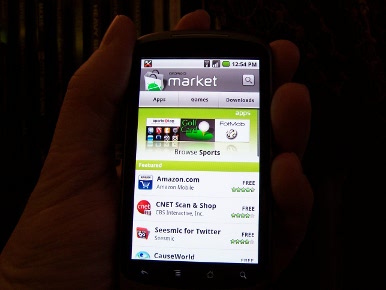 |
Generally speaking, the apps available right now are really quite good. There are stinkers to be sure, but nowhere near as many as you'll find in Apple's App Store. That undoubtedly has to do with the newness of the Android Marketplace and how much larger Apple's App Store is, but it's worth noting simply because finding cool and interesting apps means weeding through much less crap. I'm sure, over time, this will probably change.
One thing I was really impressed with was the shear number of open-source applications available in the marketplace. Frozen Bubble, various SSH tools, media players, and many others have been ported to the platform. Something I really like from a purely nerd standpoint is the fact that the marketplace includes a section for demos. Currently, most of the demos found there are ports of various existing graphical demos (like glxgears), but the potential for cool graphical demos is huge.
Conclusion
All-in-all, I've been pretty impressed with the Nexus One, and am eager to start developing for it (likely do some games on it and publish them through Funavision). It's a terribly cool phone that, so far, I've been able to find little fault with. Others have complained about lack of multitouch, but that's something I've never cared about personally, and it's supposedly fixed in the next update.
One complaint I do have about general use is that the soft keys on the face of the thing seem a bit off-center. I've seen reviewers complain about this, and it is certainly an annoyance when you first pick the phone up as the buttons don't seem to work when you press them. However, after using it for a few hours, you learn to instinctively press just a bit higher than where the symbols are on the face of the screen. It is a nuisance, but it only affects the four soft keys on the face and nothing else, so it's a fairly minor one.
But I do like my new phone, and am hoping for another 4-5 years before I have to get a new one :-)